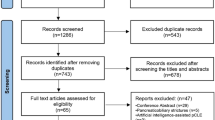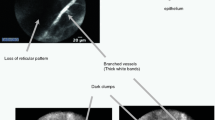Abstract
Background
Most modalities for tissue confirmation during endoscopic retrograde cholangiopancreatography (ERCP) suffer from low sensitivity and poor diagnostic accuracy. Probe-based confocal laser endomicroscopy (pCLE) was prospectively evaluated in a multicenter registry including 102 patients with indeterminate strictures and demonstrated excellent sensitivity (98 %). Yet, several false-positive cases were induced by benign inflammatory conditions resulting in a specificity of 67 %.
Aims
To evaluate the diagnostic performance of pCLE for the diagnosis of indeterminate biliary stricture; and to propose interpretation criteria for benign inflammatory conditions to reduce the number of false positives.
Methods
Sixty cases from the prospective registry were reviewed retrospectively (27 malignant, 33 benign) by a panel of three biliary endoscopists. Each case’s clinical history, ERCP impression, and corresponding pCLE sequences was used to score image quality, propose presumptive diagnoses, and rate level of diagnostic confidence.
Results
Using the Miami Classification (MC), the overall accuracy in retrospectively diagnosing malignancy in those 60 cases was 85 versus 78 % for the prospective analysis, reducing the number of false positives from 12 to 8. A second review of the false-positive cases’ pCLE sequences (benign inflammatory) helped refine the existing classification by identifying four descriptive criteria specific to benign inflammatory conditions (Paris Classification): Vascular congestion, dark granular patterns with scales, increased inter-glandular space, and thickened reticular structure.
Conclusions
The Paris Classification is a refinement of the existing Miami Classification to improve the accuracy of pCLE for diagnosing benign inflammatory strictures. Prospective multicenter studies are needed to further validate this refined classification criteria.




Similar content being viewed by others
References
Ortner ME, Caca K, Berr F, et al. Successful photodynamic therapy for nonresectable cholangiocarcinoma: a randomized prospective study. Gastroenterology. 2003;125:1355–1363.
Rösch T, Hofrichter K, Frimberger E, et al. ERCP or EUS for tissue diagnosis of biliary strictures? A prospective comparative study. Gastrointest Endosc. 2004;60:390–396.
Ponchon T, Gagnon P, Berger F, et al. Value of endobiliary brush cytology and biopsies for the diagnosis of malignant bile duct stenosis: results of a prospective study. Gastrointest Endosc. 1995;42:565–572.
Schoefl R, Haefner M, Wrba F, et al. Forceps biopsy and brush cytology during endoscopic retrograde cholangiopancreatography for the diagnosis of biliary stenoses. Scand J Gastroenterol. 1997;32:363–368.
Meining A, Chen YK, Pleskow D, et al. Direct visualization of indeterminate biliary strictures using probe-based confocal laser endomicroscopy—a multicenter experience. Gastrointest Endosc. 2011;74:961–968. Epub 2011 Jul 29.
Giovannini M, Bories E, Monges G, et al. Results of a phase I-II study on intraductal confocal microscopy (IDCM) in patients with common bile duct (CBD) stenosis. Surg Endosc. 2011;25:2247–2253.
Meining A, Shah RJ, Slivka A, et al. Classification of probe-based confocal laser endomicroscopy findings in pancreaticobiliary strictures. Endoscopy. 2012;44:251–257. Epub 2012 Jan 19.
Fritcher E, Kipp B, Halling K, et al. A multivariable model using advanced cytologic methods for the evaluation of indeterminate pancreatobiliary strictures. Gastroenterology. 2009;136:2180–2186.
Bellis M, Fogel E, Sherman S, et al. Influence of stricture dilation and repeat brushing on the cancer detection rate of brush cytology in the evaluation of malignant biliary obstruction. Gastrointest Endosc. 2003;58:176–182.
Kahaleh M, Giovannini M, Jamidar P, et al. Probe-based Confocal Laser Endomicroscopy (pCLE) for indeterminate biliary strictures: refinement of the image interpretation classification—P0098. Poster presented at: 20th United European Gastroenterology Week 2012 Oct 20–24; Amsterdam, The Netherlands.
Conflict of interest
Dr. Fabrice Cailol, Dr. Bernard Filoche, and Dr. Monica Gaidhane have no conflicts of interest to disclose. Dr. Michel Kahaleh has received grant support from Boston Scientific, Fujinon, EMcison, Xlumena Inc., MaunaKea and MI Tech. He is a consultant for Xlumena Inc.
Author information
Authors and Affiliations
Corresponding author
Rights and permissions
About this article
Cite this article
Caillol, F., Filoche, B., Gaidhane, M. et al. Refined Probe-Based Confocal Laser Endomicroscopy Classification for Biliary Strictures: The Paris Classification. Dig Dis Sci 58, 1784–1789 (2013). https://doi.org/10.1007/s10620-012-2533-5
Received:
Accepted:
Published:
Issue Date:
DOI: https://doi.org/10.1007/s10620-012-2533-5




